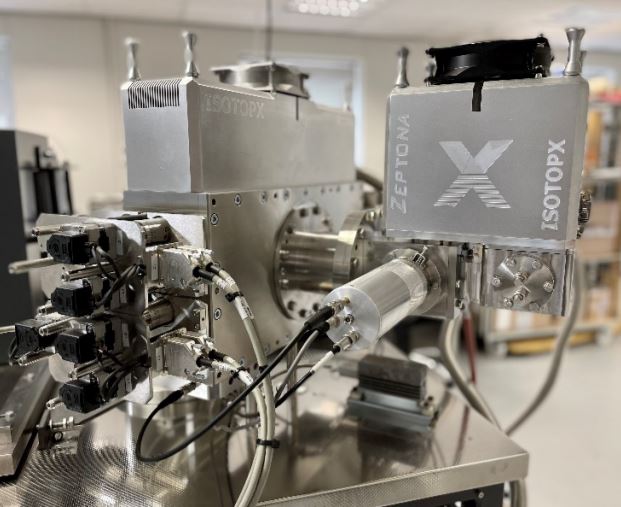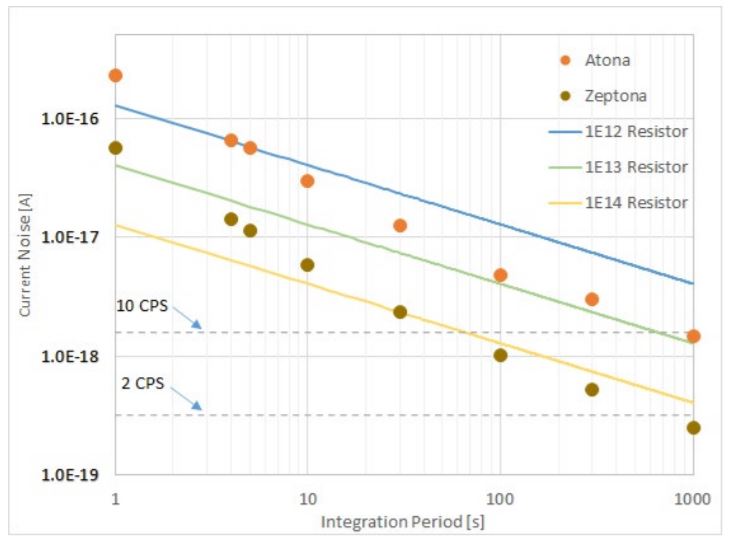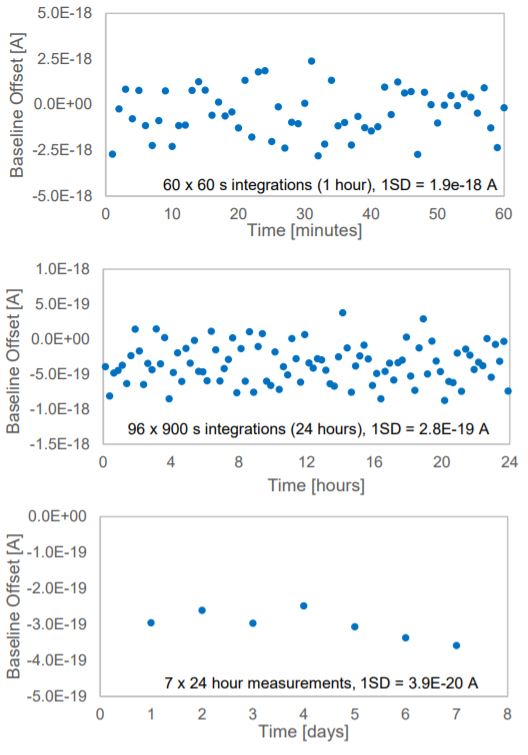Technical Note 2102
Matt Hockley, Zenon Palacz, Shaun Yardley and Tony Jones, Isotopx Ltd, Middlewich, Cheshire, UK.
Introduction
The recently developed Isotopx ATONA® Faraday amplifier represents the benchmark in ion beam signal measurement using Faraday collectors1. A further advance; the Zeptona detector system is presented in this technical note.
The Zeptona system comprises a custom designed single Faraday detector mounted behind the main multicollector of the Phoenix TIMS, fitted with an ATONA® amplifier. This combination provides an ultra low noise, low drift, high dynamic range Faraday collector that can be used in conjunction with the main ATONA® Faraday collectors and also the ion counting detectors in the main array or the ion counting Daly detector, as shown in Figure 1.

Zeptona Noise
The minimum signal intensity that may be resolved by a Faraday is determined by the noise of that detector relative to the shot noise of the signal in question. A key benefit of the Zeptona detector system is its exceptionally low noise, reducing the minimum signal intensity that may be measured. Figure 2 shows Zeptona noise performance at integration times from 1 s to 1000 s, with typical ATONA® performance and theoretical performance of resistor based amplifiers shown for comparison. Note the theoretical resistor noise assumes no other source of noise in the measuring amplifier.
The Zeptona noise is around 5 times lower than that of the ATONA® at all integration times, and is comparable to a 1e14 ohm resistor amplifier at integration time >10 s. Using 1000 s integrations, the Zeptona achieves noise below 3.2e-19 A (2CPS), implying a detection threshold of 5 x 3.2e-19 A = 1.6e-18 A (10 CPS), and allowing baselines to be determined with unprecedented precision. Additionally, the full dynamic range of the detector up to 1e-8 A (~6e10 CPS) is available with no hardware switching or range changing, in contrast to conventional resistor amplifiers systems.

Zeptona Baseline Stability
The measurement of the baseline offset of a Faraday detector is necessary to obtain accurate measurement of the ion beam intensity, with frequent measurement required to counteract drift of the baseline offset over time. The baseline offset of the Zeptona detector was measured over 1 hour (60 x 60 s integrations), 24 hour (96 x 900 s integrations) and 7 day (7 x 24 hour measurements) periods to determine both short and long term baseline stability. Figure 3 shows the collected data, with no drift apparent over any of the measurement periods. The standard deviation over 1 hour, 24 hours and 7 days is 1.9e-18 A (12 CPS), 2.8e-19 A (2.2 CPS) and 3.9e-20 A (0.2 CPS) respectively. Each of these standard deviations are consistent with the expected performance at the integration time used, confirming the absence of measureable drift over analytically significant time periods. The absolute value of the baseline offset is ~3e-19 A (2 CPS). In effect the baseline stability is so good that baseline measurements do not need to be routinely made during an analysis.

Zeptona Baselines – analytical implications
Baseline offset measurements are normally performed at several intervals during an analysis to compensate for their drift over time. This results in a trade off, where the length and frequency of interruption of the analysis to determine baselines must be balanced with the need to measure on peak to make efficient use of sample. Determination of how this trade off may be optimised is often difficult, and is particularly problematic in applications where sample size is limited and/or poorly known, where poor optimization may significantly degrade the collected data.
The exceptional stability of the Zeptona baselines over both short and long term allows the possibility of taking long, high precision baselines separately to the analysis, and then applying them to on peak data collected at a later time. For example, the baseline may be measured for several hours overnight when the instrument is normally idle, then applied during analyses the following day.
The Isotopx Isolinx instrument control software includes an Electronic Baselines (EBL) feature to allow baselines to be automatically determined and applied in this way. This method eliminates the trade off between baseline and on peak measurement time, simplifying data acquisition and improving data quality.
Conclusions
The Isotopx Zeptona detector system provides a single Faraday detector with the benefits of the ATONA® amplifier system, combined with significant improvements to noise performance and baseline stability. The Zeptona detector can potentially replace ion counting detectors in many small-beam applications, where count rates are a few thousands of CPS. The Zeptona detector however, does not need routine gain calibration both within and between analyses, thereby optimising duty cycle. Furthermore, since it uses a Faraday collector it is exceedingly robust compared with an ion counter, and requires no calibration for deadtime/linearity.
Summary
- Lowest noise Faraday detector available – comparable to 1e14 ohm resistor amplifier with integration times over 10 s.
- Excellent baseline stability – 3.9e-20 amp (1 SD) over 7 days. Equivalent to 39 zeptoamps.
- 10 orders of magnitude dynamic range – 1e-18 A to >1e-8 A can be measured on a single detector, without range changing as required with resistors.
- Retains the gain stability and tau response advantages of the ATONA®
- Software support for automated Electronic Baselines – allows baselines to be taken during instrument idle time and applied during analysis, avoiding the compromises of baseline measurement during an analysis.
- Positioned behind the focal plane – can be fitted in conjunction with the WARP filter to improve abundance sensitivity.
- Can be fitted in conjunction with a combination of up to 9 ATONA® Faradays, 10 Isotopx Ion Counting (ICC) multipliers and an ion counting Daly detector for maximum flexibility.
References
1. Introducing ATONA for TIMS – A paradigm shift in signal amplifier technology, Shaun Yardley, Zenon Palacz, Robert Guest, Matt Hockley, Isotopx Technical Note T30182, 2019.
Download Technical Note
Download the complete Technical Note: Ultra Low Noise and Baseline Drift Zeptona Faraday Detector